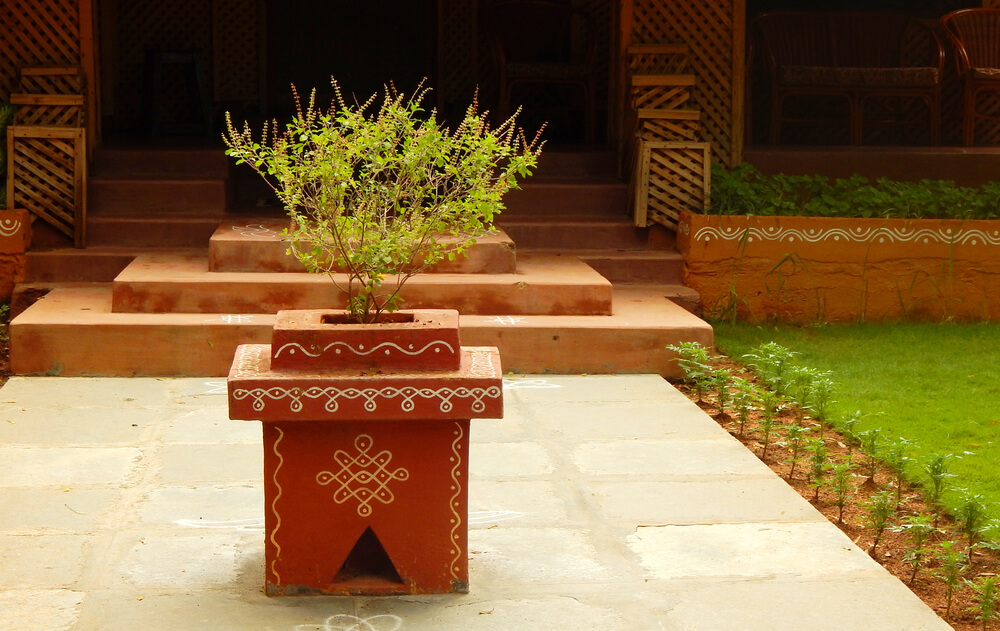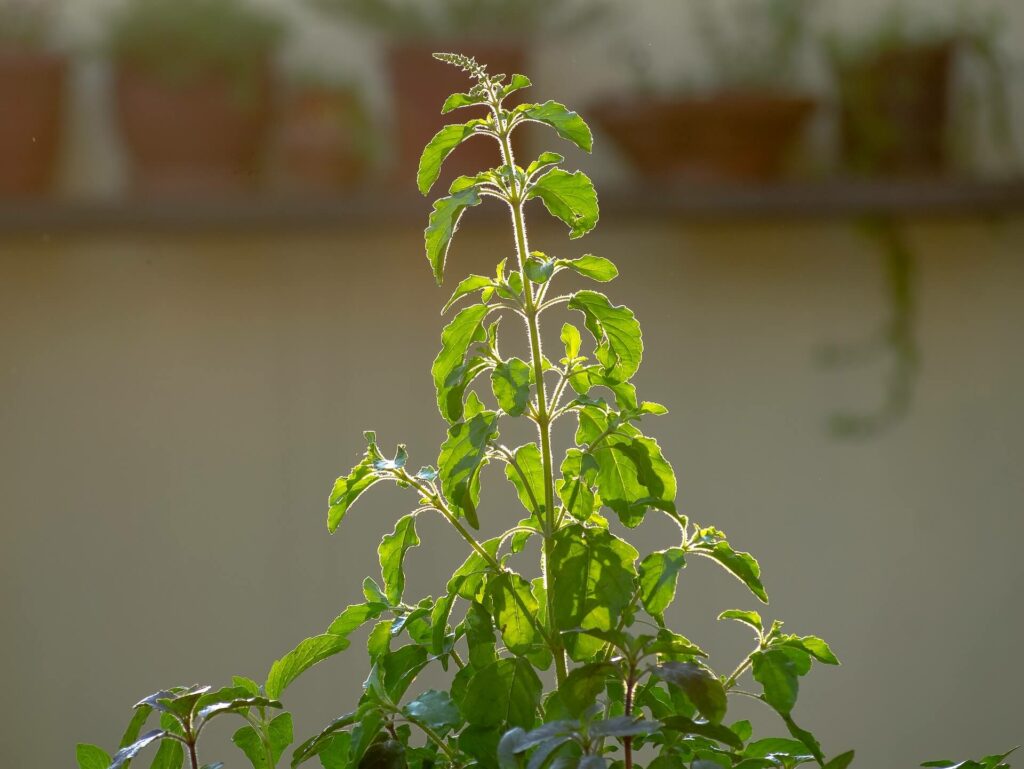Vastu Tulsi plant | Benefits | Types of Tulsi | Best direction | Best location | Number of Tulsi plants | Vastu Shastra rules | Best day | Tulsi indoor | Conclusion
Being in India, the significance of a Tulsi plant is no longer unknown to you. The Tulsi plant is considered lucky and has exceptional value in Hinduism. It is believed that planting tulsi in your house will minimize negative energy and increase positive energy and harmony.
Nevertheless, Tulsi is not just a plant with religious significance.
Renowned as “the “queen of herbs,” the Tulsi plant is prevalent in most Indian homes and has numerous medicinal and other health benefits. It is an herb that treats mild seasonal flu, common colds, and coughs.
Besides its therapeutic advantages, keeping a Tulsi plant in your house will also welcome prosperity and happiness to you and the living members of the house.
But do you know the best direction to keep your Tulsi plant at home, according to Vastu? Are you aware that owning a Tulsi plant in the wrong place can trigger Vastu Dosha?
Don’t worry! In this article, we have collated all possible information that aligns with Vastu Shastra and can help attract positivity and prosperity to your household. Check out this article if you want more Vastu tips on attracting prosperity and wealth in your home.
Why Vastu recommends to have a Tulsi plant in your home?
The basil plant, also called Tulsi, is a sacred and holy plant from the mint family that originated in the Indian subcontinent. The short perennial shrub grows to a height of one meter and has light purple to green colored leaves, and the tiny flowers you see contain seeds that disperse to give rise to saplings.
According to the Vedas, the Tulsi plant is depicted as the incarnation of the goddess Lakhsmi. Thus, wherever you grow a Tulsi plant, Goddess Lakhsmi accompanies you, attracting fortune. The plant benefits your family’s financial, emotional, and physical well-being.
The Tulsi plant may bring an abundance of positive energy into the house. According to the Vastu Shastra, it is a sacred plant that can eliminate doshas in your home. You will mostly find Tulsi growing in a four-sided structure called the Tulsi chaura. As stated in Vastu, the Tulsi plant can promote positivity and purify the environment of your residence.
Did you know most Indians worship the Tulsi plant daily? Once in the morning and the other in the evening. After offering flowers and water to the plant, most people light incense to worship the plant.

Benefits of keeping a Tulsi plant
According to the Vastu, keeping a Tulsi plant inside the house offers multiple benefits. Here are some of them:
1. Therapeutic advantages
Tulsi has been long used in Ayurveda and is widely renowned for its medicinal benefits.
- Tulsi leaves help fight infections since it has anti-viral, anti-fungal, and anti-bacterial properties.
- It helps to fight several health conditions and diseases, including heart-related disorders, cancer, bacterial infections, respiratory problems, and skin illness.
- Tulsi also helps to cure severe liver conditions.
- You may also choose to use it as a herb for cooking food, as it gives the food a unique flavor and taste.
2. Eliminates stress from the environment
Besides the health and medicinal benefits, according to Vastu shastra, a Tulsi plant can promote positive vibrations by eliminating stress and negative energies from your house.
3. Tulsi plant aids in purifying the surroundings
The Tulsi plant creates a pleasant aroma that keeps the surroundings fresh. Besides its benefits, keeping it inside the house also purifies the air quality by absorbing harmful gases like carbon monoxide, sulphur dioxide, and carbon dioxide from the atmosphere. The best part is the plant exhibits excellent mosquito-repellent qualities, keeping mosquitoes away.
4. Basil plant promotes a peaceful and blissful marital life
According to Vastu, worshipping a Tulsi plant promotes couples’ happy and blissful married life and welcomes wealth, prosperity, and peace. Therefore, a special Tulsi puja is conducted every year on the eleventh bright day of Kartik month, on the Ekadashi tithi of Shukla Paksha.
According to the Hindu religion, a Tulsi Vivah is performed these days before the start of the wedding season. This is a wedding ceremony between Lord Vishnu and Tulsi where the Tulsi plant is considered a bride, and a sacred stone called shaligrama represents Lord Vishnu as the groom.
Which type of Tulsi should you keep in your home?

Tulsi plants are widely available in two varieties- Shyama and Rama tulsi. Both of these plants are known to exhibit exceptional medicinal advantages. The green Tulsi and the holy Basil are mostly available, and according to Vastu Shastra, they are the most sacred. Let’s take a look at the different variants of Tulsi and its features:
Rama Tulsi
Rama Tulsi has green leaves, also called fortunate tulsi, Shri tulsi, or bright tulsi. It is used for several religious purposes and health benefits. In addition, the flavor of the Rama Tulsi is much sweeter than other varieties of the Tulsi plant.
Shyama Tulsi
The Tulsi with purple leaves, dark green leaves, or purple stems is called the dark Tulsi or the Shyama Tulsi. The Shyama tulsi is associated with Lord Krishna because of its dark complexion. The Shyama Tulsi, also known as the Krishna tulsi, has unique health benefits like treating skin disease, throat infections, nasal blockages, earache, and respiratory issues.
Kapoor tulsi
The Kapoor Tulsi is renowned for fighting life-threatening problems and has numerous healing properties. In addition, the aromatic smell of the Kapoor tulsi is famous for keeping insects and mosquitoes away.
Besides the Rama Tulsi, Shyama Tulsi, and Kapoor Tulsi, the other various kinds of Tulsi plants available are the wild Tulsi and the Vana Tulsi.
Which direction is best for placing your Tulsi plant?
Do you know the best direction to plant Tulsi according to Vastu principles? Well, the most preferred direction is the north. Nevertheless, if the northern side is blocked, you may also choose to place your Tulsi plant in the northeast or eastern.
However, in most homes in India, you will find a Tulsi plant thriving in a Chaura right in the middle of a yard.
Avoid placing Tulsi plants towards the southeast, southwest, west, and northwest directions to get the best results and avoid attracting negative energy. Ensure you never position the Tulsi plant incorrectly if you intend to remove negative energy and attract good vibes into the house.
Where to place your Tulsi plant?
According to Vastu Shastra, you must align with the Vastu guidelines when keeping Tulsi plants home. The east corner is the best place to place a Tulsi plant inside the house. Apart from the east direction, you can also keep your Tulsi plant near the window or the balcony facing the north and the northeast.
The north corner is the direction of the water. According to Vastu, placing a Tulsi plant in this direction will invite positive energies and create a positive environment around you. Keeping a Tulsi plant in the right direction is not enough, and you must ensure the following tips:
- Ensure that the Tulsi plant receives sufficient energy from sunlight.
- Avoid keeping dustbins, brooms, or shoes near your Tulsi plant.
- Since Tulsi is a clean plant, ensure that the area near the plant is also clean.
- Try to keep a flowering plant close to Tulsi.
- Avoid keeping thorny plants like cacti near the Tulsi plant.
- Also, never keep a dry plant near the Tulsi plant or inside the house, as it might attract negative energies.
Can you grow a Tulsi plant on the ground?
Since the Tulsi plant is sacred and worshipped throughout the year, you must not grow a Tulsi plant directly on the ground. Ensure that you place the plant in a pot or a Chaura at some height above the ground. Make sure your Tulsi plant is facing the north or northeast direction. You can grow your Tulsi plant on the balcony or the Window trail.
How many Tulsi plants should you keep in your home?
According to the principles of Vastu Shastra, you must always keep Tulsi plants in odd numbers, like five or seven, to get the best outcomes.
Vastu Shastra rules to follow to worship a Tulsi plant
According to Vastu, one must follow some guidelines while worshipping a Tulsi plant at home.
- While worshipping a Tulsi plant, ensure that the surrounding is neat and clean, as that will help you welcome positive energies to your house.
- While worshipping the plant, light a Diya near it.
- Also, give water to the Tulsi plant from the Kalash. While offering water to the plant, make sure to hold the Kalash with both hands.
- You can offer some holy items like kumkum, incense, flowers, and Haldi to your Tulsi Plant.
- While you are worshipping the plant, chant a shloka.
According to the Vastu Shastra, it is better to construct the Tulsi Chaura in the northeast corner of the house in the outdoor area or on the balcony. You can also consider the east direction for making this specific structure for your Tulsi plant.
You can also use materials like marble or wood for designing and structuring the Tulsi chaura, as that will deliver effective results. However, you must ensure that the place where you build the structure receives adequate sunlight.
What is the best day to plant a Tulsi plant in your home?
As per Vastu and Hindu beliefs, the best day to plant a Tulsi is the Thursday of the Karthick month (according to the Hindu calendar).

Can you plant a Tulsi plant indoor?
Tulsi plants may be grown inside but require sufficient lighting and maintenance. You must choose a location for the Tulsi plant where it will get adequate sunshine, such as a balcony or near a window. In addition, you must maintain a warm indoor atmosphere and keep the soil moist to promote its growth.
According to gardening professionals, you must ensure that your Tulsi plant receives at least 6 to 8 hours of sunshine daily. Therefore, you must position the plant where it will get sufficient sunlight for optimal growth.
Ready to bring a Tulsi plant to your home?
The importance of a Tulsi plant in your home cannot be overlooked, provided it can bring positivity, prosperity, and good health to your home sweet home. Are you ready to bring one home?
